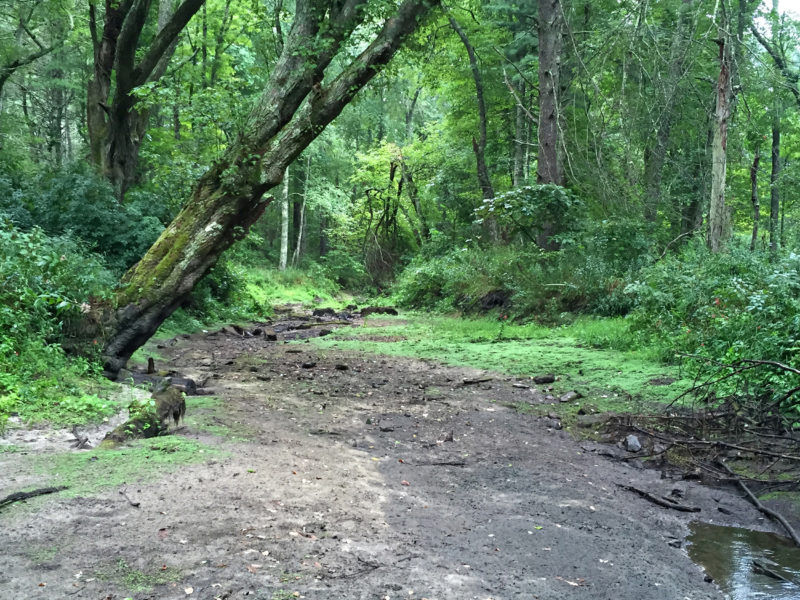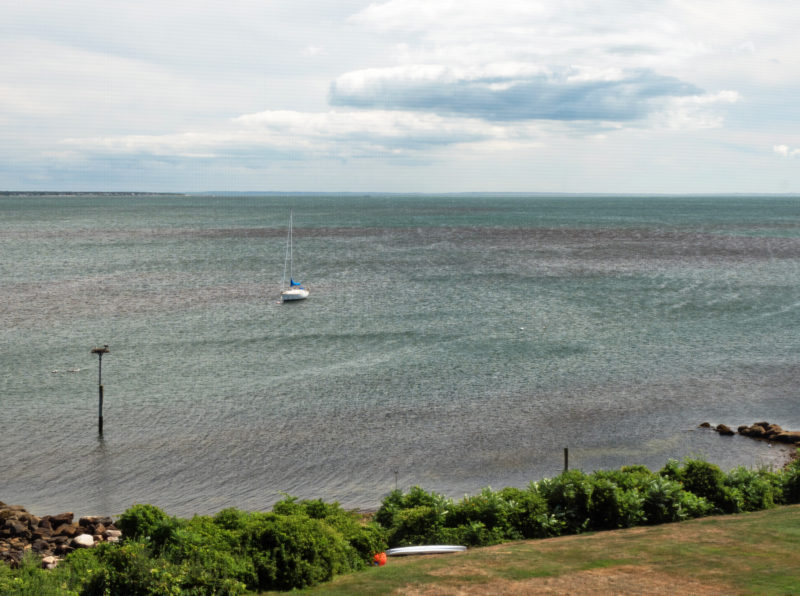Buzzards Bay health shows slight improvement during dry, hot summer of 2016
Last summer’s dry weather conditions seemed to help boost Bay Health numbers in dozens of Buzzards Bay’s local waterways from Westport to Woods Hole, according to data collected through the Coalition’s Baywatchers program. But a wet start to 2017 may mean that the Bay gets larger dose of harmful nitrogen pollution this spring.

Some of Buzzards Bay’s rivers, such as the Mattapoisett River, ran dry during the summer drought of 2016.
2016 was a year of severe drought here on Buzzards Bay and around the region. Drought years often lead to better water quality: with less rain, there’s less polluted runoff. Because so little rain fell, many of those pollutants stayed on the land instead of washing into the water.
But 2017 is already shaping up to look very different. Southeastern Massachusetts has received more than 15 inches of rain this spring – and the nitrogen that didn’t run off into the Bay last year didn’t simply disappear, according to Coalition Science Director Rachel Jakuba: “All of that nitrogen didn’t go away – we’re just getting it later.”
The vast majority of nitrogen pollution to Buzzards Bay comes from traditional home septic systems and wastewater treatment plants. Although weather can play a big role in year-to-year changes in the Bay’s health, the largest long-term improvements will happen when we continue to reduce nitrogen from wastewater.
Another piece of the nitrogen pollution pie comes from the air: vehicles and power plants release nitrogen oxides, which can travel hundreds of miles from their original sources. Federal Clean Air Act regulations passed in the 1990s, which have ratcheted down nitrogen emissions from power plants across the U.S., are slowly helping to improve the Bay’s health. Locally, this week’s permanent closure of the Brayton Point power plant in Fall River also means that less nitrogen will fall onto the Bay and damage fish populations.
“Federal regulations like the Clean Air Act benefit our local estuaries,” said Jakuba. “When there’s less nitrogen in the air, there’s less nitrogen getting into the water.”
Overall, twice as many of the Bay’s harbors, coves, and rivers had Bay Health scores that improved in 2016 compared to those that got worse or stayed the same. Roughly half of the local waterways in Buzzards Bay received a middling “fair” health grade. Just under one-third of all waterways are considered healthy and in “good” condition, while the rest are in “poor” health with unhealthy underwater habitats and too much pollution.

Rusty tide often appears as distinct reddish-brown bands in the water, like seen here near the Apponagansett Bay breakwater in Dartmouth on August 18. (Image: Tom Gidwitz)
There was one big exception to the overall improvements in Bay health last summer: a nitrogen pollution-fueled algae bloom called rusty tide. The rusty tide was first spotted in mid-August in Clarks Cove and New Bedford Harbor, where it lingered through mid-September. It was also reported in places like Apponagansett Bay, the Westport Rivers, Aucoot Cove, West Falmouth Harbor, and Cuttyhunk Harbor.
It was the first time since 2012 that the Coalition had recorded widespread rusty tide in the Bay. That’s notable because before last year, 2012 previously held the record for highest average annual temperature. Back in 2012, rusty tide bloomed throughout the Bay after an abnormally warm winter and hot summer.
“Water temperatures were even warmer last summer than in 2012, which may be why we saw rusty tide,” said Jakuba.
The drought also had the reverse effect on most of the region’s freshwater rivers last summer, which generally saw low levels of dissolved oxygen. Less rain meant that water levels were lower, which caused the water to heat up faster and become more stagnant.
Each week in summer, volunteer Baywatchers collect water quality data at more than 200 monitoring stations on 30 major harbors, coves, and rivers across Buzzards Bay. These trained volunteers measure temperature, salinity, water clarity, dissolved oxygen, and general weather conditions.
You can make a difference by volunteering as a Baywatcher in your community this summer. To sign up, fill out an online volunteer application or contact Monitoring Director Tony Williams at (508) 999-6363 x203.